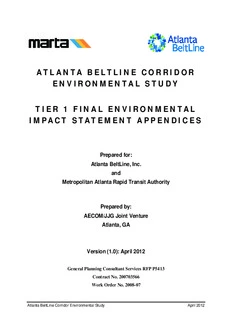
atlanta beltline corridor environmental study tier 1 final environmental impact statement appendices PDF
Preview atlanta beltline corridor environmental study tier 1 final environmental impact statement appendices
AT L A N TA B E LT L IN E C OR R ID OR E N V IRON M E N TA L S T U DY T I E R 1 F I NA L E NV IRO N M E N TA L I M PACT S TATE M EN T A P PE ND I CE S Prepared for: Atlanta BeltLine, Inc. and Metropolitan Atlanta Rapid Transit Authority Prepared by: AECOM/JJG Joint Venture Atlanta, GA Version (1.0): April 2012 General Planning Consultant Services RFP P5413 Contract No. 200703566 Work Order No. 2008-07 Atlanta BeltLine Corridor Environmental Study April 2012 Atlanta BeltLine Corridor Environmental Study April 2012 Appendix A - Tier 1 EIS/ Section 4(f) Technical Memorandum Appendix B - Notice of Intent Appendix C - Agency Coordination and Correspondence Appendix D - Data Tables and Figures Appendix E - Public Involvement Appendix F - Comments Received during Public Comment Period Appendix G Distribution List Appendix H - Acronyms and Glossary Appendix I - List of Preparers Appendix J - References Atlanta BeltLine Corridor Environmental Study April 2012 Page Left Intentionally Blank Atlanta BeltLine Corridor Environmental Study April 2012 Appendix A - Tier 1 FEIS/ Section 4(f) Technical Memorandum Atlanta BeltLine Corridor Environmental Study A April 2012 Page Left Intentionally Blank Atlanta BeltLine Corridor Environmental Study April 2012 AT LANTA BE LT LINE COR RIDOR E NVIRONM ENTAL S TUDY T IER 1 FINAL E NVIRONME NTAL IMPACT STATE ME NT / S ECT ION 4( F) T ECHNICAL MEMORANDUM Prepared for: Atlanta BeltLine, Inc. and Metropolitan Atlanta Rapid Transit Authority Prepared by: AECOM/JJG Joint Venture Atlanta, GA Version (1.0): April 2012 General Planning Consultant Services RFP P5413 Contract No. 200703566 Work Order No. 2008-07 Atlanta BeltLine Corridor Environmental Study April 2012 Appendix A: FEIS/ 4f Technical Memorandum Page Left Intentionally Blank Atlanta BeltLine Corridor Environmental Study April 2012 Appendix A: FEIS/ 4f Technical Memorandum Table of Contents 1.0 PURPOSE AND NEED ..................................................................................................................... 1-1 1.1 INTRODUCTION ........................................................................................................ 1-1 1.2 PROBLEM STATEMENT .......................................................................................... 1-3 1.3 PROJECT PURPOSE ............................................................................................... 1-3 1.4 PROJECT NEEDS ..................................................................................................... 1-4 1.4.1 Population and Employment Growth.......................................................... 1-4 1.4.2 Environmental Justice and Transit-Dependent Populations ...................... 1-5 1.4.3 Land Use and Economic Development ...................................................... 1-6 1.4.4 Effects of Projected Growth on Transportation .......................................... 1-7 1.5 PLANNING CONTEXT .............................................................................................. 1-8 1.5.1 Transportation Vision Plans ....................................................................... 1-8 1.5.2 Planned Development ................................................................................ 1-9 1.6 PROJECT GOALS AND OBJECTIVES ................................................................. 1-14 2.0 ALTERNATIVES CONSIDERED ..................................................................................................... 2-1 2.1 ALTERNATIVES DEVELOPMENT PROCESS ........................................................ 2-1 2.1.1 Study Area Definition .................................................................................. 2-1 2.1.2 Background and Initial Screening of Alternatives ...................................... 2-1 2.1.3 Public Involvement and Conceptual Engineering ...................................... 2-3 2.1.4 Feasibility Screening of Initial Build Alternatives........................................ 2-4 2.2 TIER 1 DEIS TRANSIT ALTERNATIVES ................................................................. 2-6 2.2.1 No-Build Alternative .................................................................................... 2-6 2.2.2 Transit Build Alternatives ............................................................................ 2-6 2.2.3 Evaluation of Transit Alternatives ............................................................. 2-11 2.2.4 MARTA Station Connectivity and Infill Station Alternative Areas ............ 2-18 2.2.5 Transit Mode Technologies ...................................................................... 2-20 2.3 TIER 1 DEIS TRAIL ALTERNATIVES .................................................................... 2-21 2.3.1 Preliminary Cost Estimates for Trail Alternatives ..................................... 2-23 2.3.2 Tier 1 DEIS Conclusions .......................................................................... 2-24 2.3.3 Purpose and Need Met by Preferred Trail Alternative ............................. 2-26 2.4 ALTERNATIVES CONSIDERED IN THE TIER 1 FEIS .......................................... 2-27 2.4.1 No-Build Alternative .................................................................................. 2-27 2.4.2 Preferred Transit Alternative Description ................................................. 2-28 2.4.3 Preferred Trail Alternative Description ..................................................... 2-29 2.4.4 Preferred Alternative Cost Estimates ....................................................... 2-29 2.5 SUPPLEMENTAL TRANSIT FEATURES .............................................................. 2-29 2.5.1 Transit Station Locations .......................................................................... 2-30 2.5.2 Operational Characteristics ...................................................................... 2-32 2.5.3 Vehicle Storage and Maintenance Facilities ............................................ 2-32 Atlanta BeltLine Corridor Environmental Study i April 2012 Appendix A: FEIS/ 4f Technical Memorandum 2.5.4 Transit and Multi-Use Trail Cross Sections .............................................. 2-33 3.0 AFFECTED ENVIRONMENT ........................................................................................................... 3-1 3.1 SUMMARY OF POTENTIAL ENVIRONMENTAL EFFECTS................................... 3-1 3.2 TRANSPORTATION SYSTEMS AND FACILITIES ................................................. 3-1 3.2.1 Methodology ............................................................................................... 3-1 3.2.2 Travel Patterns ........................................................................................... 3-7 3.2.3 Transit Services ........................................................................................ 3-11 3.2.4 Roadway System...................................................................................... 3-16 3.2.5 Freight Rail ............................................................................................... 3-20 3.2.6 Passenger Rail ......................................................................................... 3-27 3.2.7 Pedestrian and Bicycle ............................................................................. 3-29 3.2.8 Consistency with Transportation Plans .................................................... 3-33 3.2.9 Potential Avoidance, Minimization, and Mitigation Measures .................. 3-34 3.2.10 Subsequent Analysis ................................................................................ 3-36 3.3 LAND USE AND ZONING ....................................................................................... 3-36 3.3.1 Methodology ............................................................................................. 3-36 3.3.2 Land Use .................................................................................................. 3-37 3.3.3 Zoning ....................................................................................................... 3-45 3.3.4 Local Plans ............................................................................................... 3-48 3.3.5 Economic Conditions and Development Strategies ................................. 3-50 3.3.6 Potential Avoidance, Minimization, and Mitigation Measures .................. 3-50 3.3.7 Subsequent Analysis ................................................................................ 3-51 3.4 NEIGHBORHOODS AND COMMUNITY FACILITIES ........................................... 3-51 3.4.1 Methodology ............................................................................................. 3-51 3.4.2 Affected Environment ............................................................................... 3-51 3.4.3 Preliminary Environmental Consequences .............................................. 3-53 3.4.4 Potential Avoidance, Minimization, and Mitigation Measures .................. 3-55 3.4.5 Subsequent Analysis ................................................................................ 3-55 3.5 SOCIOECONOMICS AND ENVIRONMENTAL JUSTICE ..................................... 3-56 3.5.1 Methodology ............................................................................................. 3-56 3.5.2 Affected Environment - Socioeconomics ................................................. 3-57 3.5.3 Affected Environment - Environmental Justice ........................................ 3-66 3.5.4 Preliminary Environmental Consequences .............................................. 3-70 3.5.5 Potential Avoidance, Minimization, and Mitigation Measures .................. 3-76 3.5.6 Subsequent Analysis ................................................................................ 3-76 3.6 VISUAL AND AESTHETIC RESOURCES ............................................................. 3-77 3.6.1 Methodology ............................................................................................. 3-77 3.6.2 Affected Environment ............................................................................... 3-77 3.6.3 Preliminary Environmental Consequences .............................................. 3-78 3.6.4 Potential Avoidance, Minimization, and Mitigation Measures .................. 3-79 3.6.5 Subsequent Analysis ................................................................................ 3-79 Atlanta BeltLine Corridor Environmental Study ii April 2012 Appendix A: FEIS/ 4f Technical Memorandum
Description: